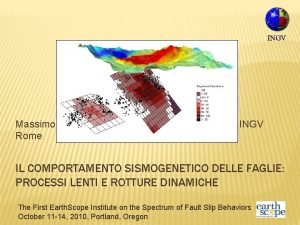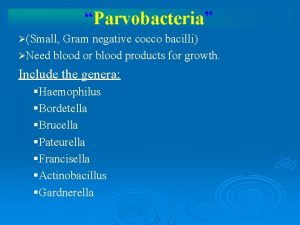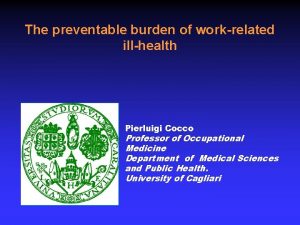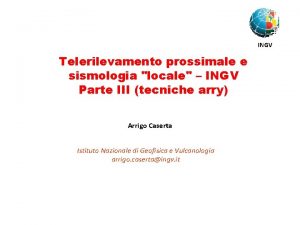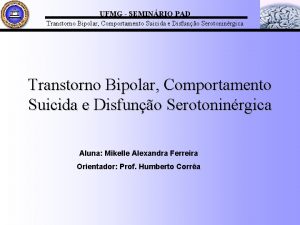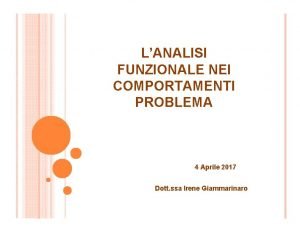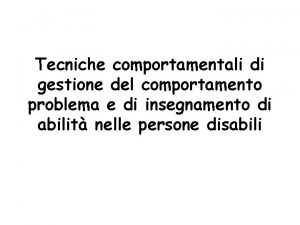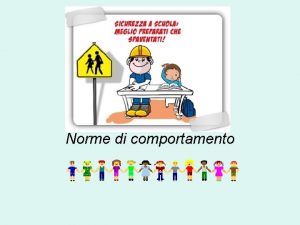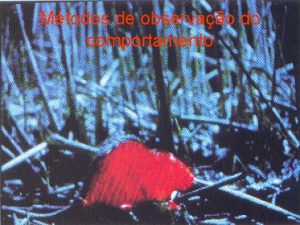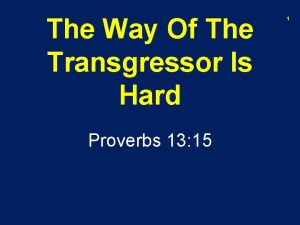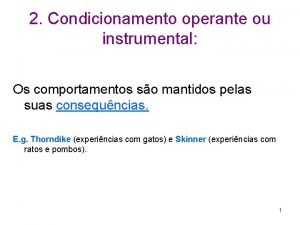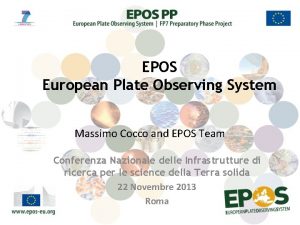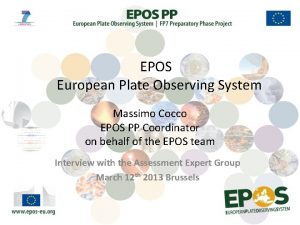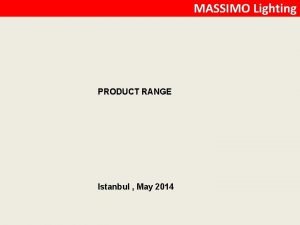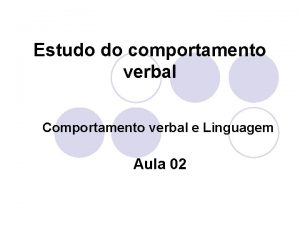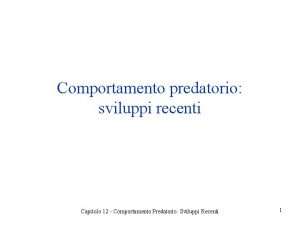INGV Massimo Cocco Rome INGV IL COMPORTAMENTO SISMOGENETICO




















- Slides: 20

INGV Massimo Cocco Rome INGV IL COMPORTAMENTO SISMOGENETICO DELLE FAGLIE: PROCESSI LENTI E ROTTURE DINAMICHE The First Earth. Scope Institute on the Spectrum of Fault Slip Behaviors October 11 -14, 2010, Portland, Oregon

FALSI PARADOSSI IN GEOFISICA The INGV Low Angle Normal Fault Paradox Seismic Slow or Aseismic Slip? and fast slip episodes? (Vr, Slip Vel. ? ) Stress drop scaling (breakdown of selfsimilarity) Role of fluids! http: //www. earthscope. org/information/meetings/workshops/past/earthscopeinstitute-on-the-spectrum-of-fault-slip-behaviors 2

MODE OF SLIP Natural faults can relieve the accumulated stress in very different ways, not limited to continuous aseismic sliding and earthquakes (Peng & Gomberg, 2010) The mode of slip depends on the intrinsic constitutive processes governing faulting episodes The physical interpretation of modern observations of slip episodes (tremors, slow slip, earthquakes, afterslip, etc…) requires the understanding of the state of stress and constitutive properties of fault zones as well as the stress evolution caused by tectonic processes and stress perturbations

FAULT SYSTEMS A key general challenge: to reconcile geological observations of natural faults and seismological & geodetic data with laboratory tests on experimental faults geology seismology Laboratory Courtesy by Eric Daub and Jean Carlson Daub, E. G. , and J. M. Carlson, Friction, Fracture, and Earthquakes, Ann. Rev. Cond. Matter Phys. 1, 397 -418 (2010).

Geological Observations Geological observations reveal that faulting and earthquakes occur in a complex volume, named the fault zone. Despite extremely thin, Principal Slipping Zones have a finite thickness Shear zone Strain localization Damage zone structure is extremely variable Fault core properties are poorly known dynamic coseismic slip episodes

SELECT A SCALE OF MACROSCOPICITY Definition of macroscopic physical quantities (slip, slip-rate, stress, . . . ) on a virtual mathematical plane of zero thickness Conscious adoption of a phenomenological description Friction should be considered in a macroscopic sense Shear traction (i. e. , stress) is friction Macroscopic frictional work contains all the mechanical energy absorbed within the fault zone Macroscopically elastic outside the fault zone t, d fault zone thickness t, d Macroscopically inelastic inside the fault zone

A PHENOMENOLOGICAL CONTACT LAW In this framework a constitutive law is a phenomenological contact law t = m (u, v, Yi, T, F, lc, h, w, Ce) sneff(sn, pfluid) It should contain a memory of previous slip episodes, as the R&S evolution law It should explicitly contain length and/or time scale parameters We can use Rate & State Friction with this meaning

SPRING SLIDER SIMULATIONS Boatwrigth & Cocco JGR 1996

FRICTIONAL CONSTRAINTS TO FAULTING Spring slider simulations under abrupt applied Spring slideran response under load and continued loading Spring slider an abrupt simulations (30 days) under a constant tectonic loading different L A=0. 5 MPa, L=1 mm k=5. 0 MPa/m This confirms that we Vo = 32 mm/y have many different sliding behaviours determined by the local frictional properties different B

RUPTURE PROPAGATION ON A HETEROGENEOUS FAULT 10

Outcome of Dynamic Fault Weakening scale dependent processes fracture friction Dynamic weakeni ng Melting Abrasion & Wear Porosity & permeability evolution Thermal Pressurization Flash Heating Physical Processes (≠ length scales) Cocco & Tinti, EPSL, 2008

CONSTRAINING DYNAMIC FAULT WEAKENING to infer the stress evolution as a function of time and slip at single points on the fault, to determine maximum slip, peak slip-rate, duration of slip episodes, …. . to image the distribution on the fault plane of the main physical quantities to constrain the slip histories and the local rupture velocity characterizing the spatial propagation therefore, assigning an effective meaning to the terms “slow” and “fast”.

KINEMATIC MODELS DYNAMIC MODELS v Slip v Traction Evolution v Rupture Time v Strength Excess v Rise Time v Dynamic Stress Drop v Rake angle v Breakdown work v Source Time Function v Dc Yoffe function Tinti et al. , BSSA 2005 Tinti et al. , JGR 2005

IMPORTANCE OF SLIP RATE By means of slip velocity history we can infer the traction change evolution on the fault plane We solve the Elastodynamic equation using the rupture history as a boundary condition on the fault Fukuyama and Madariaga (1998) Slip Velocity time history on the fault example: Slip distribution and rupture time from kinematic inversion

ADOPTED SOURCE TIME FUNCTIONS Different source time functions are currently adopted in the literature to solve both the forward and the inverse problem and to model recorded waveforms. If we limit our tasks to fitting observed ground motions and geodetic data, this choice is quite arbitrary and allows the achievement of good modelling results. However, if the inferred rupture histories are used to constrain or determine dynamic source parameters, this choice can heavily affect the results. Thus, a key issue in modelling ground motion waveforms to image earthquake ruptures and determine source parameters is the adoption of dynamically consistent source time functions. 15

THE YOFFE FUNCTION We have adopted the Yoffe function in our modelling results and we have proposed a regularized version of the original function. Nielsen & Madariaga (2000) original regularized ts 0. 15 s The regularization consists in convolving the original Yoffe function with a triangular function of given duration (ts). The details ts 0. 2 s of these 1 < tr < formulation 4 s analytical are presented in Tinti et al. (2005), BSSA. tr 2. 5 s 0. 1< ts< 1 s t. R eff= t. R +2 t. S Tinti e al. BSSA (2005) 16

3 D Uniform model: slip=1 m, Vr=2 km/s, Tacc=0. 225 s Tacc YOFFE FUNCTION Tacc cannot be constrained with seismological observations and it is associated with dynamic parameters Breakdown stress drop

FROM KINEMATICS TO DYNAMICS Slip distribution of kinematic model by Hartzell and Heaton (1983) for the 1979 Imperial Valley earthquake. slip velocity and slip time histories Traction change time histories traction change versus slip

CONCLUSIONS & KEY QUESTIONS Need to reconcile geological, geophysical and laboratory observations A challenge for TABOO & GLASS Our phenomenological approach does not allow us to distinguish the micro-scale processes controlling dynamic fault weakening A challenge for LAB The complexity of fault zones and the diversity of frictional behaviours can explain the variability of the mode of slip. Multidisciplinary research Fault Zone Observatories Slip velocity contains many info of the traction evolution and dynamic fault weakening, but unfortunately it is poorly known micro vs moderate-to-large earthquakes 19

Different slip distances: Da - D’c - Dc Cocco M. , E. Tinti, C. Marone & A. Piatanesi (2009), Scaling of slip weakening distance with final slip during dynamic earthquake ruptures. In: Fault-zone Properties and Earthquake Rupture Dynamics, edited by E. Fukuyama, International Geophysics Series, 94, Elsevier. 20
 Massimo cocco
Massimo cocco Cocco bacilli
Cocco bacilli Pierluigi cocco
Pierluigi cocco Arrigo caserta ingv
Arrigo caserta ingv Normoglicidica
Normoglicidica Comportamento
Comportamento Natura dell'amore e regole del comportamento amoroso
Natura dell'amore e regole del comportamento amoroso Analisi funzionale del comportamento
Analisi funzionale del comportamento Token economy
Token economy Prompting fading shaping modeling chaining
Prompting fading shaping modeling chaining Comportamento suicida
Comportamento suicida Situação pensamento emoção comportamento
Situação pensamento emoção comportamento Norme di comportamento in caso di terremoto a scuola
Norme di comportamento in caso di terremoto a scuola Modelo de comportamento do consumidor
Modelo de comportamento do consumidor Observação do comportamento
Observação do comportamento The way of a transgressor is hard
The way of a transgressor is hard O comportamento organizacional é um campo
O comportamento organizacional é um campo Comportamento instrumental
Comportamento instrumental Comportamento disturbante
Comportamento disturbante Comportamento grupal
Comportamento grupal Regole di comportamento internet
Regole di comportamento internet
